2010 BMW MOTORRAD G 650 GS brakes
[x] Cancel search: brakesPage 4 of 136
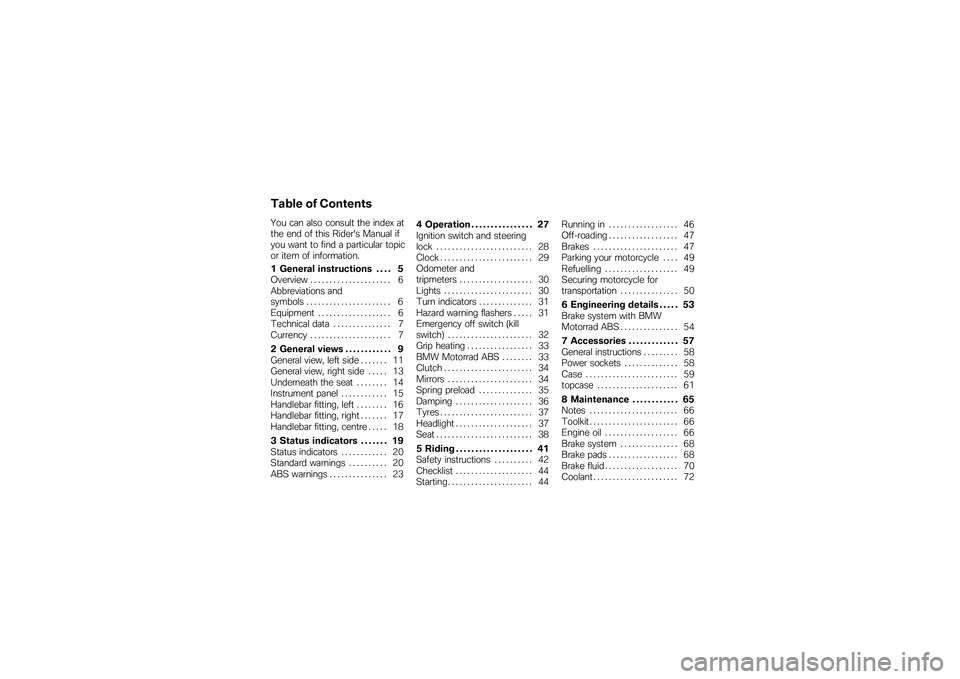
Table of Contents
You can also consult the index atthe end of this Rider's Manual ifyou want to find a particular topicor item of information.
1 General instructions . . . . 5Overview . . . . . . . . . . . . . . . . . . . . . 6Abbreviations andsymbols . . . . . . . . . . . . . . . . . . . . . . 6Equipment . . . . . . . . . . . . . . . . . . . 6Technical data . . . . . . . . . . . . . . . 7Currency . . . . . . . . . . . . . . . . . . . . . 7
2 General views . . . . . . . . . . . . 9General view, left side . . . . . . . 11General view, right side . . . . . 13Underneath the seat . . . . . . . . 14Instrument panel . . . . . . . . . . . . 15Handlebar fitting, left . . . . . . . . 16Handlebar fitting, right . . . . . . . 17Handlebar fitting, centre . . . . . 18
3 Status indicators . . . . . . . 19Status indicators . . . . . . . . . . . . 20Standard warnings . . . . . . . . . . 20ABS warnings . . . . . . . . . . . . . . . 23
4 Operation . . . . . . . . . . . . . . . . 27Ignition switch and steeringlock . . . . . . . . . . . . . . . . . . . . . . . . . 28Clock . . . . . . . . . . . . . . . . . . . . . . . . 29Odometer andtripmeters . . . . . . . . . . . . . . . . . . . 30Lights . . . . . . . . . . . . . . . . . . . . . . . 30Turn indicators . . . . . . . . . . . . . . 31Hazard warning flashers . . . . . 31Emergency off switch (killswitch) . . . . . . . . . . . . . . . . . . . . . . 32Grip heating . . . . . . . . . . . . . . . . . 33BMW Motorrad ABS . . . . . . . . 33Clutch . . . . . . . . . . . . . . . . . . . . . . . 34Mirrors . . . . . . . . . . . . . . . . . . . . . . 34Spring preload . . . . . . . . . . . . . . 35Damping . . . . . . . . . . . . . . . . . . . . 36Tyres . . . . . . . . . . . . . . . . . . . . . . . . 37Headlight . . . . . . . . . . . . . . . . . . . . 37Seat . . . . . . . . . . . . . . . . . . . . . . . . . 38
5 Riding . . . . . . . . . . . . . . . . . . . . 41Safety instructions . . . . . . . . . . 42Checklist . . . . . . . . . . . . . . . . . . . . 44Starting . . . . . . . . . . . . . . . . . . . . . . 44
Running in . . . . . . . . . . . . . . . . . . 46Off-roading . . . . . . . . . . . . . . . . . . 47Brakes . . . . . . . . . . . . . . . . . . . . . . 47Parking your motorcycle . . . . 49Refuelling . . . . . . . . . . . . . . . . . . . 49Securing motorcycle fortransportation . . . . . . . . . . . . . . . 50
6 Engineering details . . . . . 53Brake system with BMWMotorrad ABS . . . . . . . . . . . . . . . 54
7 Accessories . . . . . . . . . . . . . 57General instructions . . . . . . . . . 58Power sockets . . . . . . . . . . . . . . 58Case . . . . . . . . . . . . . . . . . . . . . . . . 59topcase . . . . . . . . . . . . . . . . . . . . . 61
8 Maintenance . . . . . . . . . . . . 65Notes . . . . . . . . . . . . . . . . . . . . . . . 66Toolkit . . . . . . . . . . . . . . . . . . . . . . . 66Engine oil . . . . . . . . . . . . . . . . . . . 66Brake system . . . . . . . . . . . . . . . 68Brake pads . . . . . . . . . . . . . . . . . . 68Brake fluid . . . . . . . . . . . . . . . . . . . 70Coolant . . . . . . . . . . . . . . . . . . . . . . 72
Page 5 of 136
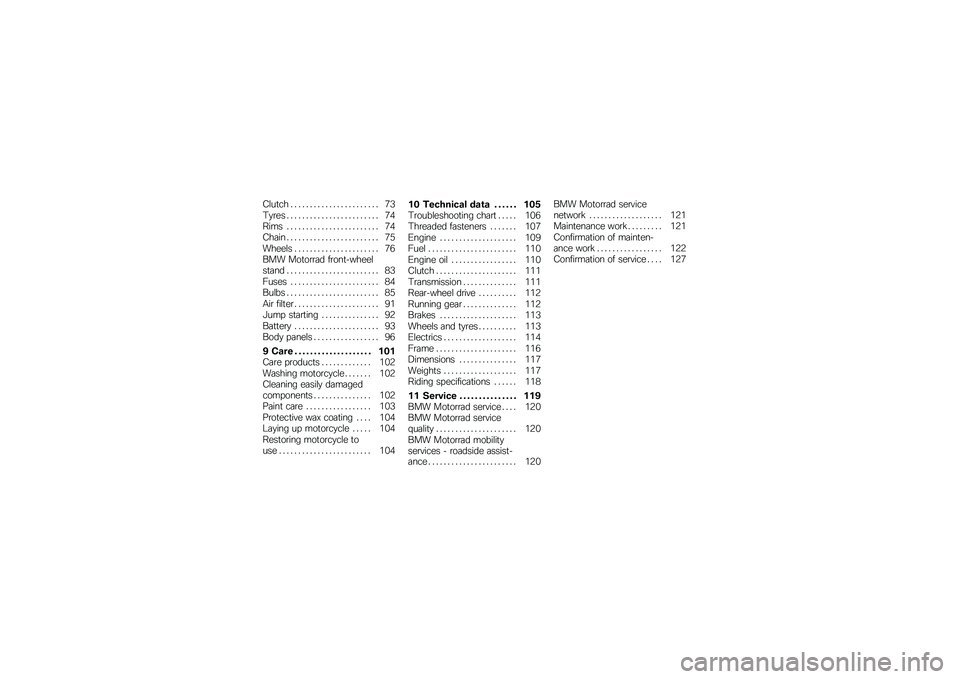
Clutch . . . . . . . . . . . . . . . . . . . . . . . 73Tyres . . . . . . . . . . . . . . . . . . . . . . . . 74Rims . . . . . . . . . . . . . . . . . . . . . . . . 74Chain . . . . . . . . . . . . . . . . . . . . . . . . 75Wheels . . . . . . . . . . . . . . . . . . . . . . 76BMW Motorrad front-wheelstand . . . . . . . . . . . . . . . . . . . . . . . . 83Fuses . . . . . . . . . . . . . . . . . . . . . . . 84Bulbs . . . . . . . . . . . . . . . . . . . . . . . . 85Air filter . . . . . . . . . . . . . . . . . . . . . . 91Jump starting . . . . . . . . . . . . . . . 92Battery . . . . . . . . . . . . . . . . . . . . . . 93Body panels . . . . . . . . . . . . . . . . . 96
9 Care . . . . . . . . . . . . . . . . . . . . 101Care products . . . . . . . . . . . . . 102Washing motorcycle . . . . . . . 102Cleaning easily damagedcomponents . . . . . . . . . . . . . . . 102Paint care . . . . . . . . . . . . . . . . . 103Protective wax coating . . . . 104Laying up motorcycle . . . . . 104Restoring motorcycle touse . . . . . . . . . . . . . . . . . . . . . . . . 104
10 Technical data . . . . . . 105Troubleshooting chart . . . . . 106Threaded fasteners . . . . . . . 107Engine . . . . . . . . . . . . . . . . . . . . 109Fuel . . . . . . . . . . . . . . . . . . . . . . . 110Engine oil . . . . . . . . . . . . . . . . . 110Clutch . . . . . . . . . . . . . . . . . . . . . 111Transmission . . . . . . . . . . . . . . 111Rear-wheel drive . . . . . . . . . . 112Running gear . . . . . . . . . . . . . . 112Brakes . . . . . . . . . . . . . . . . . . . . 113Wheels and tyres . . . . . . . . . . 113Electrics . . . . . . . . . . . . . . . . . . . 114Frame . . . . . . . . . . . . . . . . . . . . . 116Dimensions . . . . . . . . . . . . . . . 117Weights . . . . . . . . . . . . . . . . . . . 117Riding specifications . . . . . . 118
11 Service . . . . . . . . . . . . . . . 119BMW Motorrad service . . . . 120BMW Motorrad servicequality . . . . . . . . . . . . . . . . . . . . . 120BMW Motorrad mobilityservices - roadside assist-ance . . . . . . . . . . . . . . . . . . . . . . . 120
BMW Motorrad servicenetwork . . . . . . . . . . . . . . . . . . . 121Maintenance work . . . . . . . . . 121Confirmation of mainten-ance work . . . . . . . . . . . . . . . . . 122Confirmation of service . . . . 127
Page 43 of 136
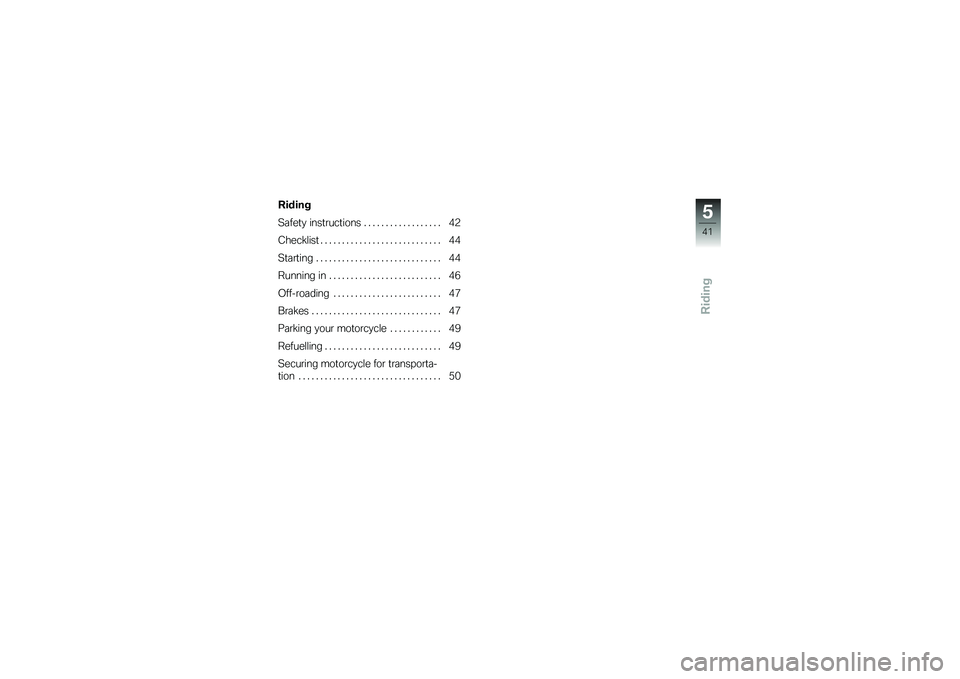
Riding
Riding
Safety instructions . . . . . . . . . . . . . . . . . . 42
Checklist . . . . . . . . . . . . . . . . . . . . . . . . . . . . 44
Starting . . . . . . . . . . . . . . . . . . . . . . . . . . . . . 44
Running in . . . . . . . . . . . . . . . . . . . . . . . . . . 46
Off-roading . . . . . . . . . . . . . . . . . . . . . . . . . 47
Brakes . . . . . . . . . . . . . . . . . . . . . . . . . . . . . . 47
Parking your motorcycle . . . . . . . . . . . . 49
Refuelling . . . . . . . . . . . . . . . . . . . . . . . . . . . 49
Securing motorcycle for transporta-
tion . . . . . . . . . . . . . . . . . . . . . . . . . . . . . . . . . 50
5
41
zRiding
Page 46 of 136
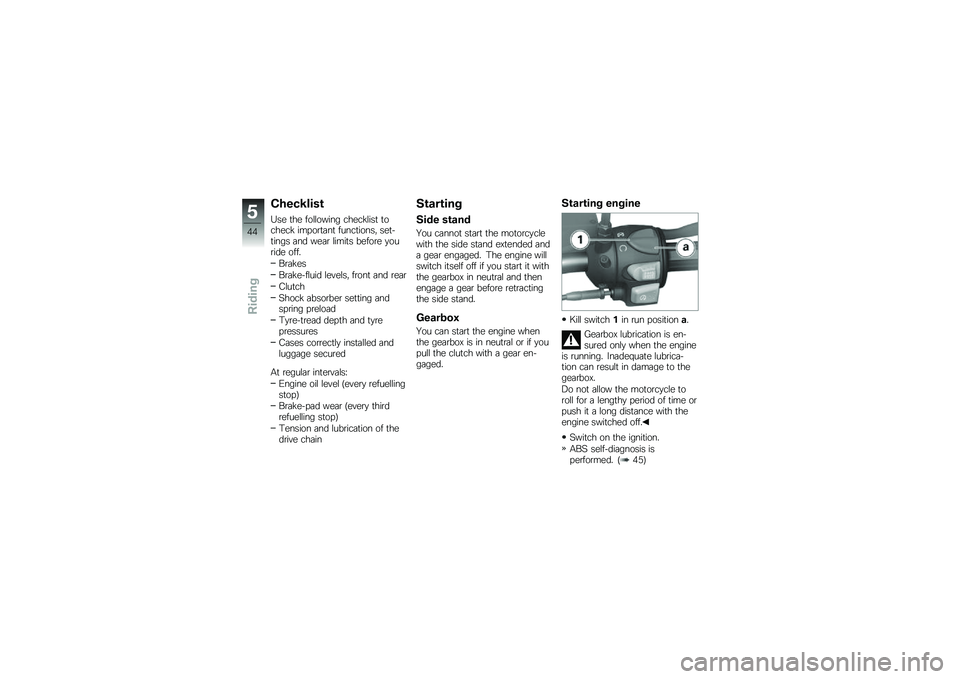
Checklist
Use the following checklist tocheck important functions, set-tings and wear limits before youride off.
Brakes
Brake-fluid levels, front and rear
Clutch
Shock absorber setting andspring preload
Tyre-tread depth and tyrepressures
Cases correctly installed andluggage secured
At regular intervals:
Engine oil level (every refuellingstop)
Brake-pad wear (every thirdrefuelling stop)
Tension and lubrication of thedrive chain
Starting
Side stand
You cannot start the motorcyclewith the side stand extended anda gear engaged. The engine willswitch itself off if you start it withthe gearbox in neutral and thenengage a gear before retractingthe side stand.
Gearbox
You can start the engine whenthe gearbox is in neutral or if youpull the clutch with a gear en-gaged.
Starting engine
Kill switch1in run positiona.
Gearbox lubrication is en-sured only when the engineis running. Inadequate lubrica-tion can result in damage to thegearbox.
Do not allow the motorcycle toroll for a lengthy period of time orpush it a long distance with theengine switched off.
Switch on the ignition.
ABS self-diagnosis isperformed. (45)
5
44
zRiding
Page 48 of 136

If an indicator showing an ABSfault appears when ABS self-dia-gnosis completes:
You can continue to ride. Bearin mind that the ABS functionis not available.
Have the fault rectified asquickly as possible by aspecialist workshop, preferablyan authorised BMW Motorraddealer.
Running in
The first 1000 km
While running in the motor-cycle, vary the throttle openingand engine-speed range fre-quently.
Try to do most of your rid-ing during this initial period ontwisting, fairly hilly roads, avoid-ing high-speed main roads andhighways if possible.
Exceeding the specified en-gine speeds while runningin will lead to increased enginewear.
Keep to the specified enginespeeds for running in.
Do not exceed the rpm limitsrecommended for running in.
Running-in speed
max 5000 min-1(for the first1000 km)
No full-load acceleration.
Avoid low engine speeds at fullload.
Do not omit the first inspectionafter 500 - 1200 km.
Brake pads
New brake pads have to beddown before they can achievetheir optimum friction levels. Youcan compensate for this initial re-duction in braking efficiency by
exerting greater pressure on thelevers.
New brake pads can ex-tend stopping distance by asignificant margin.
Apply the brakes in good time.
Tyres
New tyres have a smooth sur-face. This must be roughened byriding in a restrained manner atvarious heel angles until the tyresare run in. This running in pro-cedure is essential if the tyres areto achieve maximum grip.
Tyres do not have their fullgrip when new and thereis a risk of accidents at extremeangles of heel.
Avoid extreme angles of heel.
5
46
zRiding
Page 49 of 136
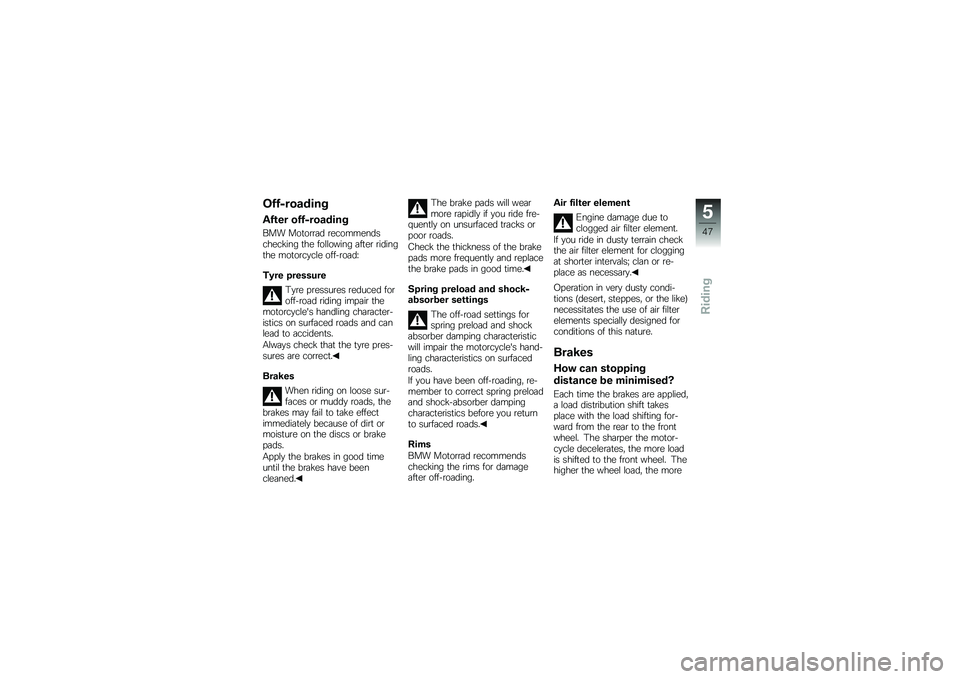
Off-roading
After off-roading
BMW Motorrad recommendschecking the following after ridingthe motorcycle off-road:
Tyre pressure
Tyre pressures reduced foroff-road riding impair themotorcycle's handling character-istics on surfaced roads and canlead to accidents.
Always check that the tyre pres-sures are correct.
Brakes
When riding on loose sur-faces or muddy roads, thebrakes may fail to take effectimmediately because of dirt ormoisture on the discs or brakepads.
Apply the brakes in good timeuntil the brakes have beencleaned.
The brake pads will wearmore rapidly if you ride fre-quently on unsurfaced tracks orpoor roads.
Check the thickness of the brakepads more frequently and replacethe brake pads in good time.
Spring preload and shock-absorber settings
The off-road settings forspring preload and shockabsorber damping characteristicwill impair the motorcycle's hand-ling characteristics on surfacedroads.
If you have been off-roading, re-member to correct spring preloadand shock-absorber dampingcharacteristics before you returnto surfaced roads.
Rims
BMW Motorrad recommendschecking the rims for damageafter off-roading.
Air filter element
Engine damage due toclogged air filter element.
If you ride in dusty terrain checkthe air filter element for cloggingat shorter intervals; clan or re-place as necessary.
Operation in very dusty condi-tions (desert, steppes, or the like)necessitates the use of air filterelements specially designed forconditions of this nature.
Brakes
How can stopping
distance be minimised?
Each time the brakes are applied,a load distribution shift takesplace with the load shifting for-ward from the rear to the frontwheel. The sharper the motor-cycle decelerates, the more loadis shifted to the front wheel. Thehigher the wheel load, the more
5
47
zRiding
Page 50 of 136

braking force can be transmittedwithout the wheel locking.
To optimise stopping distance,apply the front brakes rapidly andkeep on increasing the force youapply to the brake lever. Thismakes the best possible use ofthe dynamic increase in load atthe front wheel. Remember topull the clutch at the same time.In the "panic braking situations"that are trained so frequentlybraking force is applied as rap-idly as possible and with therider's full force applied to thebrake levers; under these circum-stances the dynamic shift in loaddistribution cannot keep pacewith the increase in decelerationand the tyres cannot transmit thefull braking force to the surfaceof the road. Under these circum-stances the front wheel can lockup.
BMW Motorrad ABS preventsthe front wheel from locking up.
Descending mountain
passes
There is a danger of thebrakes fading if you useonly the rear brakes when des-cending mountain passes. Underextreme conditions, the brakescould overheat and suffer severedamage.
Use both front and rear brakes,and make use of the engine'sbraking effect as well.
Wet and dirty brakes
Wetness and dirt on the brakediscs and the brake pads dimin-ish braking efficiency.
Delayed braking action or poorbraking efficiency must bereckoned with in the followingsituations:
Riding in the rain or throughpuddles of water.
After the motorcycle has beenwashed.
Riding on salted or grittedroads.
After work has been carried onthe brakes, due to traces of oilor grease.
Riding on dirt-covered surfacesor off-road.
Wetness and dirt result inpoor braking efficiency.
Apply the brakes lightly whileriding to remove wetness anddirt, or dismount and clean thebrakes.
Think ahead and brake in goodtime until full braking efficiency isrestored.
5
48
zRiding
Page 56 of 136
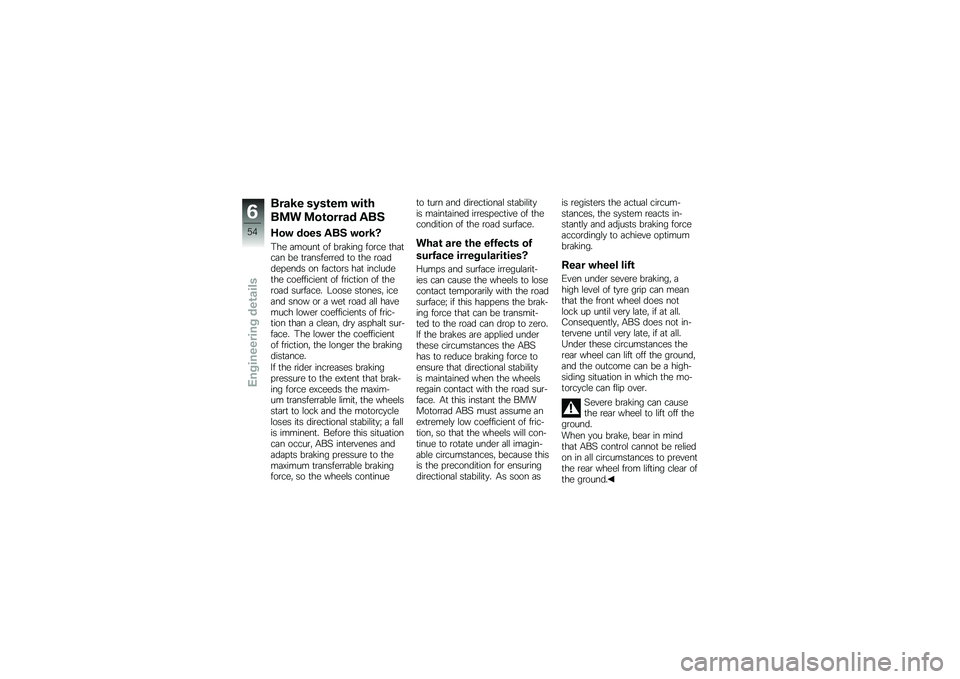
Brake system with
BMW Motorrad ABS
How does ABS work?
The amount of braking force thatcan be transferred to the roaddepends on factors hat includethe coefficient of friction of theroad surface. Loose stones, iceand snow or a wet road all havemuch lower coefficients of fric-tion than a clean, dry asphalt sur-face. The lower the coefficientof friction, the longer the brakingdistance.
If the rider increases brakingpressure to the extent that brak-ing force exceeds the maxim-um transferrable limit, the wheelsstart to lock and the motorcycleloses its directional stability; a fallis imminent. Before this situationcan occur, ABS intervenes andadapts braking pressure to themaximum transferrable brakingforce, so the wheels continue
to turn and directional stabilityis maintained irrespective of thecondition of the road surface.
What are the effects of
surface irregularities?
Humps and surface irregularit-ies can cause the wheels to losecontact temporarily with the roadsurface; if this happens the brak-ing force that can be transmit-ted to the road can drop to zero.If the brakes are applied underthese circumstances the ABShas to reduce braking force toensure that directional stabilityis maintained when the wheelsregain contact with the road sur-face. At this instant the BMWMotorrad ABS must assume anextremely low coefficient of fric-tion, so that the wheels will con-tinue to rotate under all imagin-able circumstances, because thisis the precondition for ensuringdirectional stability. As soon as
is registers the actual circum-stances, the system reacts in-stantly and adjusts braking forceaccordingly to achieve optimumbraking.
Rear wheel lift
Even under severe braking, ahigh level of tyre grip can meanthat the front wheel does notlock up until very late, if at all.Consequently, ABS does not in-tervene until very late, if at all.Under these circumstances therear wheel can lift off the ground,and the outcome can be a high-siding situation in which the mo-torcycle can flip over.
Severe braking can causethe rear wheel to lift off theground.
When you brake, bear in mindthat ABS control cannot be reliedon in all circumstances to preventthe rear wheel from lifting clear ofthe ground.
6
54
zEngineering details